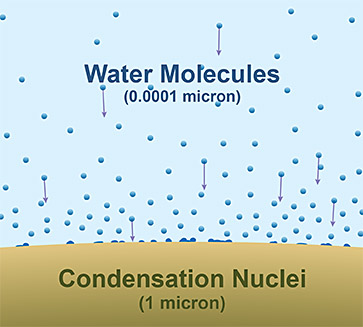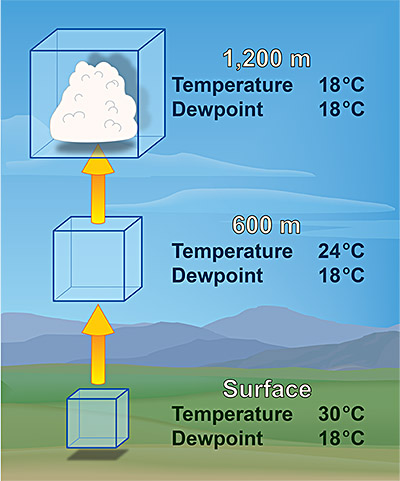There are two ingredients needed for clouds to form: water and nuclei.
Nuclei
Water is always present in Earth’s atmosphere in some form. However, water molecules on their own are too small to bond together in the formation of cloud droplets. They need a "flatter" surface, an object with a radius of at least one micrometer (one millionth of a meter) on which they can condense. Those objects are called cloud condensation nuclei.
These nuclei are minute solid and liquid particles found in abundance in the atmosphere, such as smoke from fires or volcanoes, ocean spray, or tiny specks of wind-blown soil. They are hygroscopic, meaning they attract water molecules, and are about 1/100th the size of a cloud droplet upon which water condenses.
This means that every cloud droplet has a speck of dirt, dust, or salt crystal at its core. However, even with its condensation nuclei, a cloud droplet is still essentially made up of pure water.

Temperature's role
The presence of water-attracting nuclei alone is not enough for a cloud to form; the air temperature must also be below the dew point, the point of saturation where evaporation equals condensation.
Air can reach the point of saturation in a number of ways. The most common way is through air rising from the surface up into the atmosphere and cooling.
As a block of air (a “parcel”) rises, it expands due to the lower pressure higher in the atmosphere. This expansion results in cooling. When the temperature changes due to expansion or contraction of the parcel rather than from heat transfer between the parcel and surrounding atmosphere, this is called the adiabatic process.
For each 1000-foot increase in elevation that the parcel rises, its air temperature will decrease by 5.5°F. (9.8°C per kilometer) until it reaches saturation. This is called the “dry lapse rate”.
Once the parcel reaches saturation temperature (100% relative humidity), water vapor will condense onto the cloud condensation nuclei, resulting in the formation of a cloud droplet.
However, the atmosphere is in constant motion. As air rises, drier air is entrained, or mixed into the rising parcel, and both condensation and evaporation are continually occurring. As a result, cloud droplets are constantly forming and dissipating. When more water condenses on nuclei than evaporates from them, clouds form and grow. Conversely, if there is more evaporation than condensation, clouds dissipate. This is why clouds appear and disappear as well as constantly change shape.
Learning Lesson: Smoking Clouds



